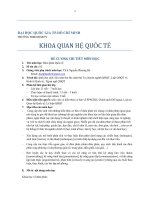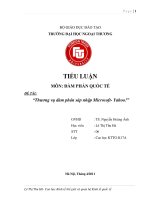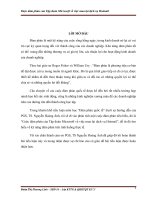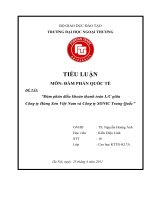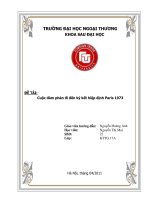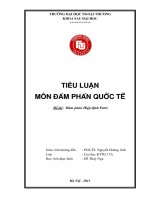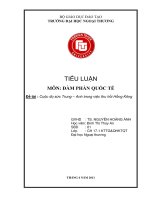slide đàm phán quốc tế ftu session 8 persuasion ethics and team building in negotiation
Bạn đang xem bản rút gọn của tài liệu. Xem và tải ngay bản đầy đủ của tài liệu tại đây (393.1 KB, 27 trang )
Session 8
Persuasion, Ethics & Team
Building in Negotiation
CuuDuongThanCong.com
/>
Part 1
Principles of Persuasion
2
CuuDuongThanCong.com
/>
Social Judgment Theory
• We cannot evaluate messages without
reference to existing attitudes.
• The theory explains certain phenomena of
persuasive message processing.
• Underlying the theory is the premise that
people know their attitudes.
3
CuuDuongThanCong.com
/>
Latitudes of the Mind
• Latitude of Commitment–where firmly
attitudes already exist.
• Latitude of Non-commitment–where little or
no prior attitude exists.
• Latitude of Acceptance–where persuasive
messages are similar to existing attitudes.
• Latitude of Rejection–where persuasive
messages are at odds with existing attitudes.
4
CuuDuongThanCong.com
/>
Latitudes of the Mind
• Some portion of the latitude of commitment
will constitute the latitude of rejection.
• Some portion of the latitude of commitment
may be included within the latitude of
acceptance.
• Persuasion is most likely in the latitude of noncommitment.
5
CuuDuongThanCong.com
/>
Cognitive Dissonance
• Psychological tension created by receiving
messages inconsistent with prior beliefs and
attitudes, or by behavior that is inconsistent
with beliefs and attitudes, or by inconsistent
behaviors.
• The tension motivates us to achieve
consonance.
• An unconscious cognitive phenomenon.
6
CuuDuongThanCong.com
/>
Reducing Dissonance
Unconsciously we:
Perceive statements as more similar than they
are.
We think others’ attitudes are the same as
ours.
We change the relative importance of
attitudes.
We forget inconsistent attitudes.
We reject inconsistent attitudes as invalid.
7
CuuDuongThanCong.com
/>
Negativity Bias
Negative information weighs more heavily, is
perceived as more valid, and is remembered
longer than positive information.
8
CuuDuongThanCong.com
/>
How to Persuade
• Focus your arguments with ACES.
“A” = Appropriate
“C” = Consistent
“E” = Effective
“S” = Special particular additional reasons
9
CuuDuongThanCong.com
/>
Crossing the CREEK
•
•
•
•
•
“C” = Common ground
“R” = Reinforcing facts and data
“E” = Emotional connection
“E” = Empathy
“K” = the KEY is credibility
10
CuuDuongThanCong.com
/>
When Persuasion Is Unlikely
• Reframe. Look for more ACES.
• Re-load to cross the CREEK–more common ground,
more facts, more emotional connection, more
empathy, more credibility.
• Ask the reason for non-acceptance.
• Identify the contrary/inconsistent attitude.
• Demonstrate consistency–or recognize that
persuasion is not possible at this time with the focus
and arguments used.
11
CuuDuongThanCong.com
/>
Diplomacy
• Assertion and diplomacy are always
appropriate in negotiation.
• Diplomacy is the restraint of power.
12
CuuDuongThanCong.com
/>
Part II
Ethics In Negotiation
13
CuuDuongThanCong.com
/>
Three Major Views of
Ethical Conduct
• The end justifies the means.
• Absolute truth versus relative truth.
• There is not such thing as the truth.
14
CuuDuongThanCong.com
/>
Ethical Negotiation:
Questionable Strategies
• Lying (and its effects on negotiation issues) on:
–
–
–
–
–
–
Positions
Interests
Priorities and preferences
BATNAs
Reservation prices
Facts
• Other questionable negotiation strategies
–
–
–
–
–
Traditional competitive bargaining
Manipulation of an opponent’s network
Reneging on negotiated agreements
Retracting an offer
Nickel-and-diming
15
CuuDuongThanCong.com
/>
Conditions under which Negotiators Say
They Would Engage in Deception (i.e., Lying) in
Negotiations
100%
90%
80%
70%
60%
50%
43%
38%
40%
30%
21%
19%
20%
15%
15%
13%
10%
9%
4%
CuuDuongThanCong.com
pi
e
Fi
xe
d
Di
sl
ik
e
n
ta
t io
re
pu
po
w
Lo
or
de
w
er
at
h
t
gh
ca
u
ng
Li
fe
Pr
ot
ec
t
No
t
ge
t ti
na
lg
ai
n
t
sh
o
Pe
rs
o
O
ne
Li
efo
r
-a
-li
e
0%
16
/>
Review of Categories
(Left to Right on X-Axis)
Lie-for-a-lie: When I suspect the other party is deceiving me
One shot: In a one-shot situation, with no potential for a long-term
relationship
Personal gain: If there was a gain to be had
Not getting caught: If I felt I could get away with it
Life or death: If the situation was “life or death”
Low power: If the other party had more power (i.e., to “level the playing
field”)
Protecting reputation: When I would not have to worry about my
reputation
Dislike: If I did not like the other person
Fixed pie: If the situation was purely distributive
17
CuuDuongThanCong.com
/>
Psychological Bias and
Unethical Behavior
• Human biases that give rise to ethical problems in
negotiation
–
–
–
–
Bounded ethicality
Illusion of superiority
Illusion of control
Overconfidence
• How can negotiators calibrate ethical behavior?
–
–
–
–
The front page test
Reverse golden rule
Role modeling
Third-party advice
18
CuuDuongThanCong.com
/>
How People Justify Unethical Tactics
•
•
•
•
•
•
•
“It was unavoidable”
“It was harmless”
“It helped avoid negative results”
“It helped accomplish good results”
“The other party deserved it”
“Everybody’s doing it”
“It was fair, under the circumstances”
19
CuuDuongThanCong.com
/>
Defusing Unethical Behaviors
•
•
•
•
•
•
Ignore it
Identify it
Warn them
Set ground rules
Tell them the consequences
Act
20
CuuDuongThanCong.com
/>
Part III
Team Building in Negotiation
21
CuuDuongThanCong.com
/>
Team Negotiation
• Use teams when the matter is complex and requires
varying expertise.
• Go solo when issues are limited and you have all
necessary information and expertise.
• Go solo when time is short. Take advantage of
behind-the-scenes help, if possible.
22
CuuDuongThanCong.com
/>
Team Negotiation (continued)
• Teams add complexity but diversity increases
team ability.
• Conflict may arise within the team from
personality, style, perception, and
communication difficulties.
• Choosing complementary personalities and
expertise and allow time for team development.
• Constructive conflict is a primary benefit of using
teams.
23
CuuDuongThanCong.com
/>
Maximizing Benefits of Teams
•
•
•
•
•
•
Establish rules of conduct and roles.
Use of good guy/bad guy with teams.
Plan to negotiate among each other.
Continually diagnose and monitor conflict.
Manage constructive conflict.
Resolve destructive conflict.
24
CuuDuongThanCong.com
/>
Defining Roles within a Team
Roles
Responsibilities
Leader
•conducting the negotiation
•ruling on matters
Good guy/girl
•showing understanding for the
opposition
•intimidating the opposition
•stopping the negotiation
•keeping the team focused
•emphasising difficulties
•bringing all views together
•suggesting ways out of a deadlock
Bad guy/girl
Hardliner
Sweeper
25
CuuDuongThanCong.com
/>

